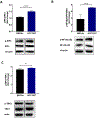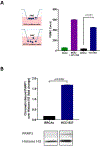Differential immunomodulatory effect of PARP inhibition in BRCA1 deficient and competent tumor cells
- PMID: 33285109
- PMCID: PMC8668236
- DOI: 10.1016/j.bcp.2020.114359
Differential immunomodulatory effect of PARP inhibition in BRCA1 deficient and competent tumor cells
Abstract
Poly-ADP-ribose polymerase (PARP) inhibitors are active against cells and tumors with defects in homology-directed repair as a result of synthetic lethality. PARP inhibitors (PARPi) have been suggested to act by either catalytic inhibition or by PARP localization in chromatin. In this study, we treat BRCA1 mutant cells derived from a patient with triple negative breast cancer and control cells for three weeks with veliparib, a PARPi, to determine if treatment with this drug induces increased levels of mutations and/or an inflammatory response. We show that long-term treatment with PARPi induces an inflammatory response in HCC1937 BRCA1 mutant cells. The levels of chromatin-bound PARP1 in the BRCA1 mutant cells correlate with significant upregulation of inflammatory genes and activation of the cyclic GMP-AMP synthase (cGAS)/signaling effector stimulator of interferon genes (STING pathway). In contrast, an increased mutational load is induced in BRCA1-complemented cells treated with a PARPi. Our results suggest that long-term PARP inhibitor treatment may prime both BRCA1 mutant and wild-type tumors for positive responses to immune checkpoint blockade, but by different underlying mechanisms.
Keywords: BRCA1 mutant; Cancer; Inflammation; PARP chromatin-bound.
Copyright © 2020 Elsevier Inc. All rights reserved.
Figures






References
-
- Sharma P. & Allison JP The future of immune checkpoint therapy. Science (80-. ). 348, 56–61 (2015). - PubMed
Publication types
MeSH terms
Substances
Grants and funding
LinkOut - more resources
Full Text Sources
Other Literature Sources
Medical
Research Materials
Miscellaneous

